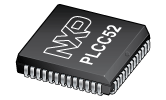Application Note (8)
Data Sheet (1)
Package Information (1)
-
plastic leaded chip carrier; 52 leads[SOT238-2]
Sign in for a personalized NXP experience.
The 28C94 quad universal asynchronous receiver/transmitter (QUART) combines four enhanced Philips Semiconductors industry-standard UARTs with an innovative interrupt scheme that can vastly minimize host processor overhead. It is implemented using Philips Semiconductor's high-speed CMOS process that combines small die size and cost with low power consumption.
The operating speed of each receiver and transmitter can be selected independently at one of eighteen fixed baud rates, a 16X clock derived from a programmable counter/timer, or an external 1X or 16X clock. The baud rate generator and counter/timer can operate directly from a crystal or from external clock inputs. The ability to independently program the operating speed of the receiver and transmitter make the QUART particularly attractive for dual-speed channel applications such as clustered terminal systems.
Each receiver is buffered with eight character FIFOs (first-in-first-out memories) and one shift register to minimize the potential for receiver overrun and to reduce interrupt overhead in interrupt driven systems. In addition, a handshaking capability is provided to disable a remote UART transmitter when the receiver buffer is full (RTS control).
The 28C94 provides a power-down mode in which the oscillator is stopped and the register contents are stored. This results in reduced power consumption on the order of several magnitudes. The QUART is fully TTL compatible and operates from a single +5V power supply.

1 result
Exclude 1 NRND
Part | CAD Model | Application | Channel | Operating Temperature (°C) | Number of pins | Receiver/Transmitter type | Function |
|---|---|---|---|---|---|---|---|
Data Communication | 4 | -40~85 | 52 | Quad UARTs | SC28L194 |
Quick reference to our documentation types.
1-10 of 11 documents
Compact List
There are no results for this selection.
Please wait while your secure files are loading.
1-10 of 11 documents
Compact List

Receive the full breakdown. See the product footprint and more in the eCad file.
There are no recently viewed products to display.

Help us improve your experience on our site. We invite you to take our five-question survey.